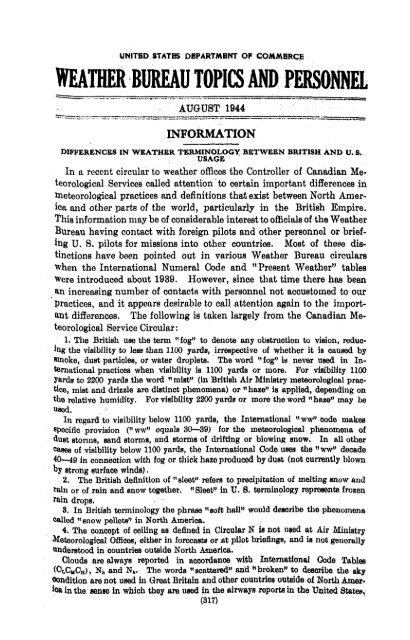Weather Bureau topics and personnel / United ... - Index of - NOAA
Weather Bureau topics and personnel / United ... - Index of - NOAA
Weather Bureau topics and personnel / United ... - Index of - NOAA
You also want an ePaper? Increase the reach of your titles
YUMPU automatically turns print PDFs into web optimized ePapers that Google loves.
UNITED STATBS DEPARTMBM OF COMMBRCE<br />
WEATHER 1BUREAU TOPICS AND PERSONNEL<br />
---s- ---_ ______._.<br />
------<br />
AUGUST 1944<br />
INFORMATION<br />
-^I- -.+-_<br />
--<br />
DIFFERENCES IN WEATHER TERMINOLOGY BETWEEN BRITISH AND U. S,<br />
USAGE<br />
In a recent circular to weather <strong>of</strong>fices the Controller <strong>of</strong> Canadian Meteorological<br />
Services called attention to oertain importaiit differences in<br />
meteorological practices <strong>and</strong> definitions that exist between North America<br />
<strong>and</strong> other parts <strong>of</strong> the world, particularly in the British Empire.<br />
This information may be <strong>of</strong> considerable interest to <strong>of</strong>ficials <strong>of</strong> the <strong>Weather</strong><br />
<strong>Bureau</strong> having contact with foreign pilots <strong>and</strong> other <strong>personnel</strong> or briefing<br />
U. 5. pilots for missions into othor countries. Most <strong>of</strong> thme distinctions<br />
have been pointed out in various <strong>Weather</strong> <strong>Bureau</strong> circulars<br />
When the International Numeral Code <strong>and</strong> “Present <strong>Weather</strong>” tables<br />
Were introduced about 1989. However, since that time there haa been<br />
an increasing number <strong>of</strong> contact8 with <strong>personnel</strong> not accustomed to our<br />
Practices, <strong>and</strong> it appears desirable to call attention again to the important<br />
difforencos. Tho following is taken largely from the Canadian Meteorological<br />
Service Circular :<br />
1. The British use the term rcfog” to denote any obstruction to vision, xvducjng<br />
the visibility to lees than 1100 yards, irrespective <strong>of</strong> whether it is caused by<br />
emoke, dust particles, or water dropleta. The word rrfog” is never ueed in Inkrnational<br />
practices when visibility is 1100 yards or more. For vieibility 1100<br />
yards to 2200 yards the word “rniatpJ (in British Air Ministry meteorological pmctice,<br />
mist <strong>and</strong> drizzle are distinct phenomena) or haze” is applied, depending on<br />
the mlative humidity. For visibility 2200 yards or mom the word 11 hams’ may be<br />
used.<br />
In mgard to visibility below 1100 gnrde, the Intarnational c r ~ ~ code p p makes<br />
speciflo provieion (I‘ ww” equals 80-49) for the meteorological phenomena <strong>of</strong><br />
dust storins, B<strong>and</strong> storms, <strong>and</strong> storms <strong>of</strong> drifting or blowing snow. In all other<br />
caw <strong>of</strong> visibility bolow 1100 yards, tho International Code uses the rlww” decade<br />
40-4 in conneation with fog or thick ham produced by dust (not currently blown<br />
by etrong surface winds).<br />
2, The British doanition <strong>of</strong> tt81eetJJ refom to precipitation <strong>of</strong> mdting mow <strong>and</strong><br />
rain or <strong>of</strong> rain <strong>and</strong> snow together. “SleetJ’ In U. 8. terminology represents froeen<br />
rain dropa.<br />
3. In British torminology the phrase “s<strong>of</strong>t hail” would daeoribe the phenomena<br />
called ((snow pellets” in North America.<br />
4. The ooncept <strong>of</strong> ceiling as defined in Circular N is not used at Air Ministry<br />
&teoroiogical Offlw, either in forecaste or at pilot brieflnp, <strong>and</strong> is not generally<br />
understood in oountria outside North America.<br />
Olouds arealways reported in amordance with International Oode Tabla<br />
(ULC~U,), Nh <strong>and</strong> Nh. The words “scattered” ana “brdken” to describe the sltg<br />
O<strong>and</strong>ition are not used hi Great Britain <strong>and</strong> other countdell outeide <strong>of</strong> Xorth Amor.<br />
In the Benee in which they are uaed in the airways reports in the <strong>United</strong> Stam,<br />
(317)

















